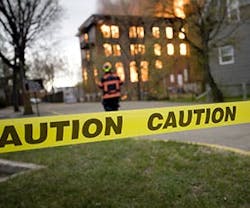Green Building and Fire Safety Hazards
Could green building practices pose unanticipated life-safety hazards?
Researchers from the Worcester Polytechnic Institute (WPI) are investigating the fire safety risks associated with green construction, thanks to a $1 million grant from the U.S. Department of Homeland Security. The grant will support the three-year project aimed at identifying and reducing the potential for firefighter and occupant injuries and deaths that could be associated with hazards posed by green building elements.
This research will begin to quantify the fire hazards and risks associated with green building features, identify ways to mitigate those hazards and risks, and prepare the fire service to fight fires in buildings with green features and elements. These are all needs identified by the National Association of State Fire Marshals, the Fire Protection Research Foundation, and the National Fire Service Research Agenda.
In 2012, Brian Meacham, associate professor of fire protection engineering at WPI, co-authored Fire Safety Challenges of Green Buildings, a report commissioned by the Fire Protection Research Foundation, the research arm of the National Fire Protection Association.
For the report, Meacham and his team conducted a global literature search and surveyed agencies around the world to assemble a list of 78 green building features and construction elements that could have implications for fire safety. They then derived a list of potential hazards associated with the features and elements, including greater flammability, faster burn rate, and increased hindrance to firefighters, as compared with conventional construction.
For example, while lightweight engineered lumber (LEL) uses less material, LEL flooring could present risks to firefighters because of a propensity to collapse under fire conditions more quickly than conventional timber construction. Photovoltaic panels generate green electricity, but a rooftop solar array may pose an ignition hazard, can readily burn once ignited, and may continue to produce electricity as long as the sun is out, posing an electrocution hazard.
The research project funded by Homeland Security will enable Meacham, who is principal investigator, to explore further some of the potential risks and hazards identified in the report.
